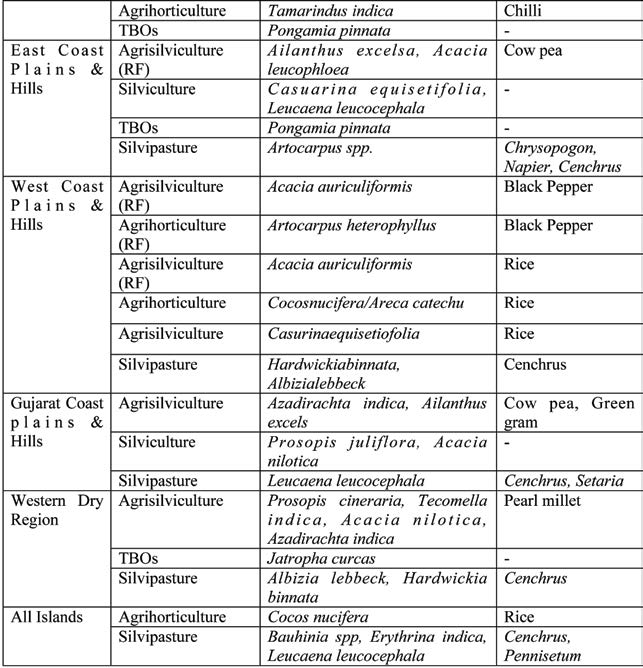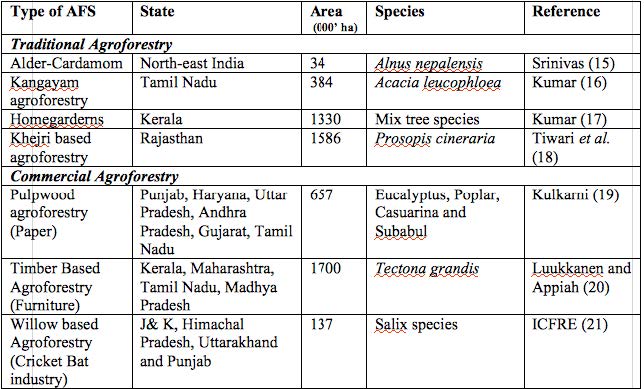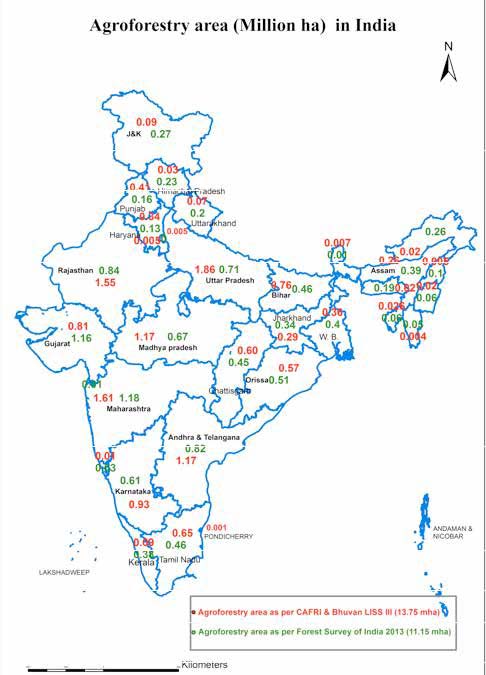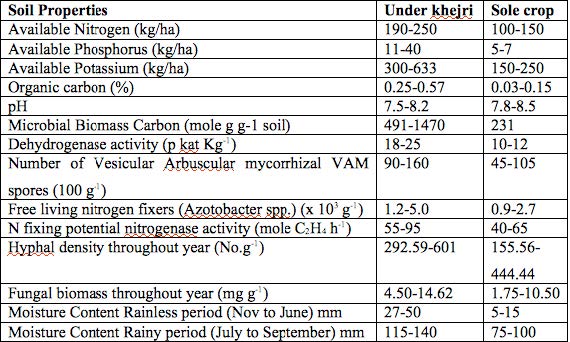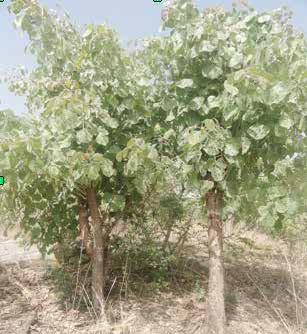Innovative agroforestry for livelihood security in India
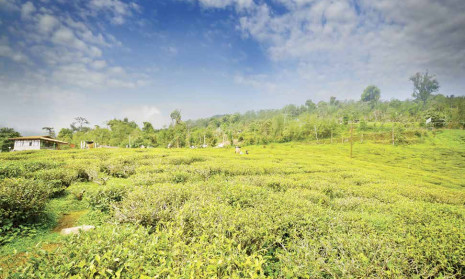
Agroforestry is practised by millions of farmers worldwide, and has been a feature of agriculture for millennia.
It encompasses a wide range of trees that are grown on farms and in rural landscapes, and includes the generation of science-based tree enterprise opportunities that can be important in the future (1).
As per the World Bank 2004 report an estimated 1.2 billion rural people currently practise agroforestry on their farms and in their communities and depend upon its products. Almost 10% of the world’s agricultural area is under agroforestry (2), whereas Nair et
al. (3) estimated the total area under agroforestry was 2.35 billion ha.
At present agroforestry meets almost
half of the demand of fuel wood, two thirds of that for small timber, 70-80% wood for plywood, 60% raw material for paper pulp and 9-11% of the green fodder requirement of livestock, besides meeting the subsistence needs of households for food, fruit, fibre, medicine etc.
However, at present the biomass productivity per unit area is less than 2 t ha-1yr-1. Agroforestry practices have demonstrated that this could be safely increased to10 t ha-1yr-1 by carefully selecting tree-crop combinations.
The area under forest is degrading due to demographic pressure and infrastructure growth needs while the agricultural area is almost stable. In India, nearly 120.72 million ha land or 37% of the total geographical area is under one or other forms of soil degradation (e.g. water erosion: 93 million ha (Mha), wind erosion: 11 Mha, salt affected soils: 6.74 Mha and 16.53 Mha of open forest area) (4). Up to March 2007, 56.54 Mha has been treated under various watershed development programmes, however, a sizeable area is yet to be treated.
Agroforestry can play a vital role in such endeavours by meeting the diverse needs of people resorting to them as inter-dependent benefits of the three components, viz. trees, crops and livestock in addition to the 6Fs, i.e. food, fruit, fodder, fuel, fertiliser and fiber (5) from limited land resources. Trees are integral to our traditional farming systems, for the innumerable benefits that they provide.
However, over time, with shrinking land holdings, annual crops have replaced trees for various reasons. Trees complement farming in terms of manure, fodder and fuel needs of the farmer. They form the backbone for practicing integrated farming systems which is necessary for self reliant and sustainable agriculture.
Owing to diverse options and products, agroforestry systems provide opportunities for employment generation in rural areas. Increased supply of wood in the market has triggered a substantial increase in the number of small-scale industries dealing with wood and wood based products in the recent past.
Diversity of agroforestry systems
The Diagnosis and Design (D&D) survey of the existing agroforestry system was conducted to identify suitable species and traditional agroforestry practices.
The various improved agroforestry practices and systems, such as home gardens, block plantation, energy
plantation, shelterbelts and improvement or alternative to shifting cultivation, are some of the specialised agroforestry systems developed.
Dhyani et
al. (6) have reported the common twenty agroforestry systems being practised in different agro-ecological regions of India and these are, 1. Agri-silviculture; 2. Boundary plantation; 3. Block plantation; 4. Energy plantation (trees + crops during initial years); 5. Alley cropping (hedges + crops); 6. Agri-horticulture (fruit trees + crops); 7. Agri-silvi-horticulture (trees + fruit trees + crops); 8. Agri-silvi-pasture (trees + crops + pasture or animals); 9. Silvi-olericulture (tree + vegetables); 10. Horti-pasture (fruit trees + pasture or animals); 11. Horti-olericulture (fruit tree + vegetables); 12. Silvi-pasture (trees + pasture/ animals); 13. Forage forestry (forage trees + pasture); 14. Shelter-belts (trees + crops); 15. Wind-breaks (trees + crops); 16. Live fence (shrubs and under- trees on boundary); 17. Silvi or Horti-sericulture (trees or fruit trees + sericulture); 18. Horti-apiculture (fruit trees + honeybee); 19. Aqua-forestry (trees + fishes); and 20. Homestead (multiple combinations of trees, fruit trees, vegetable etc).
Agronomic practices for raising the promising multipurpose tree species (MPTS) in association with annual crops have been developed and standardised.
The All India Co-ordinated research Programme on Agroforestry (AICRP-AF) and ICAR-Central Agroforestry Research Institute Jhansi recommends Morus
and
Grewia-based system for the western Himalayas, alder-based for the North Eastern Hill (NEH) region, poplar-based for the Indo-Gangetic region, aonla and Khejri-based for the semi-arid and arid regions, teak-based for the tropical region and Gmelina and Acacia-based system for humid and sub humid regions. Homegardens in Kerala and other coastal states promote food security and diversity and provide basic needs of food, fuel-wood (7, 8) fodder, plant-derived medicines, and cash income from their small holdings (9). In addition, agroforestry practices have been intertwined with the various programmes/schemes like watershed development, rehabilitation of problem soils, treatments of degraded and other wastelands etc. (10). Deliberate growing of trees on field bunds (risers) and in agricultural fields as scattered trees, and the practice to utilise the open interspaces in the newly-planted orchards and forests for cultivating field crops are also widespread in the sub-continent (11). It is estimated that currently agroforestry (outside the forest) has a greater number of trees than the “State” forests (12). The prominent agroforestry system from different region of the country are enumerated and presented in Table 1.
Potential and area under agroforestry
The increasing human and cattle population has increased demand of food and fodder in India to an alarming extent, as there is little scope to increase food production by increasing the area under cultivation.
Food production can only be increased from the land already under cultivation or from land not conventionally considered arable. A management system needs to be devised that is capable of producing food from marginal agricultural land and that is also capable of maintaining and improving the quality of the environment.
Agroforestry has both productive and protective potential so can play an important role in enhancing the productivity of our land to meet the demands of the human and livestock populations. The area under agroforestry in India as well as in the rest of the world is a debatable issue. The number of trees vary from one (arid region of Rajasthan) to 200 per ha (Home gardens of Kerala) and there is no standard procedure to estimate them.
Chavan et
al. (5) have documented the current approximate area under agroforestry as approximately 25.32 m ha, or 8.2%of the total geographical area of the country according to Dhyani et
al. (1). Based on data from CAFRI, Jhansi and Bhuvan LISS III, the area under agroforestry is 13.75 m ha (13). However, the Forest Survey of India (14) estimated the same as 11.54 m ha, which is 3.39% of the geographical area of the country.
Figure 1 shows the area under agroforestry as estimated by two different agencies in India. Various literature surveys were undertaken to present the area under different traditional and commercial agroforestry systems in India (Table 2)
Agroforestry for food and nutritional security
The country’s food production has increased five-fold since independence but recent improvements in food supply have been insufficient to fulfil the nutritional needs of the average person owing to the increasing population.
As per estimates of economic survey in 2015 the wheat and rice yield was 90.76 and 102.54 million
tonne respectively, which have the greatest increase in yields, while production of coarse grains (40.22 m t) and pulses (17.38 mt) has changed only marginally. Increasing the production and consumption of protein-dense foods, pulses in particular, will be necessary if the country is to meet its protein needs.
Agroforestry with appropriate tree-crop/legume combination is one option. The different agroforestry systems provide the desired diversification to increase the food security of the country and act as a shield against poor production during drought and other stress conditions.
Agroforestry also provides nutritional security because of diverse production systems which include fruit, vegetables, oilseed crops, medicinal and aromatic plants in addition to normal food crops grown by the farmers. Vegetable crops yield a higher return on an average than the common field crops.
Crops like peas and cowpeas can be grown successfully during winter and summer months respectively under trees and these crops can also fix the atmospheric nitrogen and improve the fertility status of the soil along with providing additional income from the production of vegetable crops.
Agroforestry has the immense potential to increase and sustain the food production per unit area in systems like the Prosopis
cineraia-based agroforestry system of the arid region of India (22).
The case study on Prosopis
cineraria will provide light on the role of agroforestry in the arid region.
Case study 1. Prosopis cineraria-based agroforestry in the arid regions of Gujarat and Rajasthan, India
Khejri (Prosopis
cineraria) is an indigenous tree growing in the tropical dry and thorn forests of North-western parts of India.
The tree is also called the King
Tree of the Great Indian Desert due its multiple benefits in conserving the fragile desert ecosystem. Since time immemorial, Khejri has been the friend of arid dwellers, providing all types of ecosystem services (food, fodder, shade, shelter, fuel, aesthetic value, improving soil fertility etc.).
Khejri is a nitrogen-fixing leguminous tree having characteristics of a phreatophyte root system which enables it to obtain water from the zone of saturation or capillary fringe and makes moisture available to the agricultural crops in the upper strata of soil. Thus, there is no competition between trees and crops/grasses for soil moisture. It is also reported that vegetative growth is high under trees, as it is known to increase the fertility status of the soil.
Moreover, in agroforestry nutrient cycling takes place by three main tree-mediated process. 1) Increased input of nitrogen through biological nitrogen fixation (BNF) by trees. 2)
Enhanced availability of nutrients through production and decomposition of substantial quantities of tree biomass. 3) Greater uptake and utilization of nutrients from deeper layers of soil by trees. Apart from this, root tissues are continuously sloughed off and replaced. These sloughed off tissues, along with senescent and dead roots, contribute a significant addition of organic matter to the soil ecosystem. The soil fertility enhancement status has been given in Table 3.
Agroforestry is playing an important role in optimising nutrient cycling, organic matter production and reducing a need for the external input of fertilisers; however the information on the inputs and outputs of the nutrient system is lacking. In the light of the present-day situation, it can be said that the Khejri tree serves as an ‘island of fertility’ in an ecosystem where resources are very much limited.
Thus, more attention should be focused on saving this ‘Lifeline tree of the desert ecosystem’ for evergreen agriculture productivity and livelihood security.
Khejri is known to improve yields of associated crops such as cow pea, cluster bean, pearl millet, mustard, Taramira, wheat and mung bean mainly due to its deep root system and having little competition with crops for nutrients and moisture. Moreover this tree has nitrogen fixing ability (Table 4).
Though the tree is present in a scattered form in arid environments, it is beneficial to maintain a tree density of 100-200 trees per hectare that can increase crop yield by 15 to 20% compared to sole crops. The tree is lopped for fodder and fuelwood. Lopping practices in winter helps for winter crops. Prosopis cineraria trees are lopped annually to gain maximum fodder yield, however, trees of more than 75 cm diameter can be lopped for maximum returns (28). This agroforestry is considered as the most sustainable basis and is helping to increase food production in arid regions of India.
Agroforestry systems have been developed for different agro-ecological regions of the country. In addition to providing higher returns, these also improve livelihood security as a cover against crop failure due to climatic aberrations, particularly in arid and semi-arid regions (Fig 3).
Some of the important activities which can be integrated with agroforestry for livelihood security include lac cultivation.
Conventional tree hosts of lac like ber (Zizyphus mauritiana) and Palas (Butea monosperma) can easily be integrated in bunds of cropped fields. Other quick-growing hosts like Flemingia semialata hold potential for integration in farming system models for lac production.
Another option is to integrate sericulture as of the four hosts of the silk worm viz., Mulberry (Bombyx mori), Tasar (Antheraea myllitte), Eri (Phelosamia ricini) and Muga (Antheraea assamensis) are cultivated in India.
The silk worm insect can feed on leaves of different agroforestry tree species such as Terminalia tomentosa (asan), T. arjuna (arjun) and Shorea robusta (sal) for the Tasar insect; the commonly used Morus alba, M. indica, M. serrata and M. latifolia for the mulberry insect can be included in the agroforestry models.
As per study of Sridhar et al. (29) the lac cultivation on Butea monosperma-based agroforestry is quite helpful for livelihood security in drought-prone regions of Central India and a single tree of Butea monosperma can produce 1.5-2.5 kg and gives an annual income of Rs 700/- to Rs 800/- (10-12 US$). An apiculture-based agroforestry system is another option which will not only provide additional income to the farmers, but will also result in other benefits to the agricultural production due to the role of honeybees as pollinators.
A number of agroforestry tree species have been identified which can act as host species for honey bees and there is ample scope for including such trees in different agroforestry models to sustain round-the-year honey production. Gums and resins form another important group of non-wood forest products. India is traditionally the largest producer of guar gum and karaya gum. Gum-yielding trees species such as Acacia senegal (gum Arabic), Acacia nilotica, Butea monosperma (Bengal kino gum) and Boswellia serrata (yielding salai guggul) are potential species for agroforestry models and need to be promoted on a large scale to provide sustained income and livelihood security to resource poor rural masses (Fig 5). Venkatesh et al. (30) reported that a single tribal family can collect up to 65 kg of Butea gum and earn a maximum amount of Rs 2628 (40-42 US$).
Agroforestry for employment opportunities
The role of agroforestry products and environmental services to meet the subsistence needs of low income households and providing a platform for greater and sustained livelihood of the society have been highlighted (31).
Increased supply of wood has triggered a substantial increase in the number of small-scale industries dealing with wood and wood based products. Such industries promote agroforestry and contribute to an increasing area of farm forestry. Recognizing agroforestry as a viable venture, many business corporations, limited companies such as ITC, WIMCO, West Coast Paper Mills Ltd, Hindustan paper Mills Ltd., and financial institutes, such as IFFCO, have entered into the business on a large scale and have initiated agroforestry activities in collaboration with farmers.
One of the major contributions of agroforestry for the economy is the livelihood impact, both in terms of income and employment generation. Besides the existing agroforestry practices, there is a potential to increase employment by up to 943 million person days annually from the 25.4 Mha of agroforestry. In the Indian Himalaya alone there is an estimated potential increase of 5.763 million person days each year (10).
The Alnus nepalensis-based agroforestry system of Sikkim state is an excellent example of the dependency of people on agroforestry for employment which is distributed on 34,000 ha in north-east India (32).
Case study 2: Alder-large cardamom based agri-silviculture system of North-east India
The first inhabitants of Sikkim, the Lepchas, collected capsules of large cardamom from natural forests.
New plantations and large patches of large cardamom based agroforestry systems have been converted in to monocultures of N2 fixing actinorrhizal Alnus nepalensis as a shade tree. Other common trees are Schima wallichii, Engelhardtia acerfolia, Eurya acuminate, Leucosceptrumc anum, Maesachisia, Symplocos theifolia, Ficus nemoralis, F. hookeri, Nyssa sessiliflora, Osbeckia paniculata,Viburnum cordifolium, Litsaea polyantha, Macaranga postulata,etc.
Thus, it is conducive to the conservation of tree biodiversity in the north eastern region. Large-scale land use transition in maximizing the benefits to meet the rising demands for food and other ecosystem services for the well being of society has been the main problem confronting sustainable development in mountain areas. Agroforestry is one of the favoured land management systems in the mountains. This case study analyses the role of a traditional large cardamom (Amomum subulatum) agroforestry system on enhancing the ecosystem services in the Eastern Himalayas.
A total of 16,949 cardamom holdings have been recorded in Sikkim State, most of which are smaller than 1 half
(Fig 7). The large cardamom-based agroforestry system is observed to accelerate nutrient cycling, increases soil fertility and productivity, reduces soil erosion, conserves biodiversity, conserves water and soil. It serves as a carbon sink, improves the living standards of the communities by increasing the farm incomes and provides aesthetic values for the mountain societies.
Cardamom agroforestry stores 3.5 times more carbon than rainfed agriculture, showing potential mitigation possibilities of the agroforestry by sequestration of the atmospheric carbon. Agroforestry is an efficient management system where the ratio of output to input is more than 13 compared to rainfed agriculture. Cost benefit analysis shows that cardamom agroforestry is profiting the farmers by 5.7 times that of rainfed agriculture.
This agroforestry system is a unique example of the ecological sustenance and economic viability for the mountain peoples while providing goods and services to downstream users. In the large-scale land use change the role of cardamom agroforestry is quite promising for ecological and economic sustainability.
Large cardamom agroforestry is almost a closed system that does not depend on the external input. The system requires about 800 to 1000 kg/ha of raw fuel-wood for curing the capsules that can be managed from the shade trees within the agroforestry. The annual production of woody biomass in cardamom based agroforestry ranges between 4.5 to 5.5 t/ha which is more than five times the fuel wood requirement for curing. The share of gross income from large cardamom (Rs. 20.7 million or 4.1 million US $) was next to cereals over Sikkim state income from all crops for the year 1995-96. The benefit –cost ratio is more than 6 from the fourth year onwards (Sharma et al. 32)
Agroforestry for fodder production
Trees and shrubs often contribute substantial amounts of leaf fodder in arid and semi-arid and hill regions during the lean period, through lopping/pruning of trees, popularly known as top feed.
The leaf fodder yield depends on species, initial age, lopping intensity and interval, as well as agro-climatic conditions. Fodder from trees is provided by leaf twigs and pods. This forage is usually rich in proteins, vitamins and minerals like calcium. They are however in general low in phosphorus and crude fibre. Top feed plays an important role in human food security through the function as an animal feed resource.
The importance of top feeds increases with the severity of drought and progression of the drought season. Other uses such as for live fencing, are complementary, as they encourage cultivation of the species and increase the availability of feed. The top feeds are considered very important in vegetation stabilisation and sustained productivity of rangelands. They also play an important role as windbreaks and by providing shade for grazing animals.
The most important top feed species are Prosopis cineraria, Albizzia lebbeck. Acacia spp, Leucaena leucocephala, Dalbergia sissoo, Ailanthus excelsa, Azadiracta indica, Acacia leucophoela for the arid and semi –arid regions and Grewia optiva, Morus alba, Celtis australis for the hilly regions.
Tree fodder provides enough nutrients and can serve very well as a green fodder supplement. In addition, leaves are also conserved in the form of hay and silage to supplement feed during shortages.
Agroforestry for bio-fuel production
A large part of India’s population, mostly in rural areas, does not have access to conventional source of energy.
Biofuels are gaining worldwide acceptance as a solution for problems of environmental degradation, energy security, restriction of imports, rural employment and improving the agricultural economy.
Trees with potential as biofuel include Jatropha curcas, Pongamia pinnata, Simarouba, Azadiracta indica, Madhuca spp., etc. In agroforestry these can be intercropped with annual crops such as cowpea, sesame, sunflower, French bean, black gram, green gram and groundnut. The promotion of oil crops also provides a poverty alleviation option in rural areas, as vacant waste and marginal land can be used for these trees, providing annual produce and income. The increased green cover will also benefit the environment. These oils are also CO2 neutral, mitigating the Green House Effect. The major source of biofuels in India is non-edible oil seeds i.e. tree borne oilseeds (TBOs). The requirement for TBOs in the country as per the National Oilseeds and Vegetable Oils Development Board, Gurgaon (India)
exceeds 5 million tons.
However, only 0.8-1.0 million tons are being collected from various species, such as Neem (Azadirachta indica), Karanj (Pongamia pinnata), Mahua (Madhuca longifolia), Jatropha (Jatropha curcas), Kusum (Schleichera oleosa), Pilu (Salvadora oleoides), Bhikal (Prinsepia utilis), Undi (Calophyllum inophyllum), Simarouba glauca, Sal (Shorea robusta) and Jojoba (Symondsia chinensis).
Some of the TBO species can be grown in wasteland under relatively unfavourable environmental conditions and such species should be promoted. They meet the dual objectives of rehabilitating wasteland and providing an energy substitute (33). However, there is still a need for research on genetic improvement for increasing seed and oil yield.
Agroforestry for bio-energy
In rural areas 70-80% energy comes through biomass from trees and shrubs.
Due to the agroforestry initiatives, large amounts of wood are now being produced from outside the conventional forestlands. Small landholdings and marginal farmers, through short rotation forestry and agroforestry practices are now providing the bulk of country’s domestically produced wood products.
Prosopis juliflora is the major source of fuel for the power generation plants in Andhra Pradesh. The fuel wood potential of indigenous (Acacia nilotica, Azadirachta indica, Casuarina equisetifolia, Dalbergia sissoo, Prosopis cineraria and Ziziphus mauritiana) and exotic (Acacia auriculiformis, A. tortilis, Eucalyptus camaldulensis and E. tereticornis) trees with calorific values from 18.7 to 20.8 MJ DM kg-1for indigenous tree species and 17.3 to19.3 MJ DM kg-1 for exotics.
Species such as C. equisetifolia, Prosopis juliflora, Leuceana leucocephala and Calliandra calothyrsus have become prominent due to their potential for providing wood energy of the highest efficiency, a shorter rotation and of high adaptability to diverse habitats and climates. Agroforestry plantations on community land and live fences on farm boundaries have immense potential in this regard. There is also an option for biomass-based power plants, where electricity generation can use crop/plant residue as another option.
Chouhan et al. (34) conducted an extensive study on the socioeconomic status of fuelwood utilization in the Bendelkhand region of India and concluded that plantations of locally available multipurpose tree species can be promoted in the region in wasteland, community and private land (Fig 9). Moreover, the use of biomass as one of the sources of energy (through agro-forestry, for example) in the semi arid Bundelkhand region, not only improved livelihood, but will also bring better ecological health to this area.
In continuation of this, Chavan et al. (35) carried out fuelwood analysis of farmer preferred tree species and recommended Acacia catechu, Acacia senegal, Anogeissus pendula and Prosopis juliflora as a best fuel-wood tree species for agroforestry plantation in the Bundelkhand region.
Economics of agroforestry systems in India
There are studies from different parts of the country suggesting that agroforestry is more profitable to farmers than agriculture or forestry for a particular area of land.
Ram Newaj and Rai (36) analyzed 13 years of an aonla-based agroforestry system in marginal lands under rainfed conditions and found a B:C ratio of 3.28 (on a discounted rate, 2.61) which indicated its profitability. Similarly, there are studies indicating profitability of the system.
A comprehensive analysis indicates (Table 5) their economic viability, with an IRR ranging from 25 to 68 and a B:C ratio of 1.01 to 4.17 for 24 agroforestry systems in various agro-climatic regions of the country (37).
Agroforestry models adopted by farmers in the upper Gangetic region and especially in Haryana, Punjab and Western Uttar Pradesh are highly lucrative, therefore, being very attractive to farmers. In these areas poplar planted on agricultural fields and on field boundaries are harvested after a 6 to 8 year rotation, and the average economic return of poplar based agroforestry systems is very high compared to that of a sole agriculture crop.
A kinnow-based horti-agricultural system is highly remunerative. In general, an average gross income of Rs.50,000 to Rs.1,00,000/acre (Rs.125000-250000/ha) is obtained from a Kinnow plantation after 6-7 years depending upon tree density and management. The net return from the agricultural crops after 4 years of plantation is considerably less because of reduced yields.
The economic feasibility of Eucalyptus hybrid both with and without agriculture under varying spacing viz. 2.5×2.5 m, 3×1.5 m, 4×2 m and 6×1 m in Haryana state was estimated by Dhillon and Bangarwa (38). This study indicates that cultivation of eucalyptus at wider spacing (6×1 m) with rotation of 8 years in combination with agricultural crops on farm lands gives a maximum NPV and B/C ratio of 2.28.
The influence of eucalyptus trees grown as a single row on one side of the field in East-West direction on the growth and yield of wheat was studied in Haryana state.
Poplar-based agroforestry has been very successful in Northern States, but we do not have a similar agroforestry model for other parts of the country, except for Eucalyptus and Casuarina.
It was because of the success of these trees in Agroforestry, credit support was provided by banking institutions.
Hence, there is tremendous scope for promoting viable agroforestry models for different agro-ecological regions of the country through quadripartite arrangement of industries, banks, research institutes and farmers.
Research Institutes under the Indian Council of Forestry Research and Education and Indian Council for Agricultural Research have developed a number of agroforestry models, but these are mostly restricted to research farms.
These models need to be used commercially for the improvement of the farmer’s livelihood.
A Task Force sub-committee has identified technically feasible and financially viable agroforestry models for different agro-ecological regions of the country in order to solicit bank finance for tree farming (Table 5) (39).
National Agroforestry Policy of India
India launched the much-needed National Agroforestry Policy, 2014 –the first of its kind in the world.
The New Agroforestry Policy is a path-breaker in making agroforestry an instrument for transforming lives of the rural farming population, protecting the ecosystem and ensuring food security through sustainable means.
The major highlights of the Policy are: 1) establishment of Institutional setup at National level to promote Agroforestry under the mandate of Ministry of Agriculture;
2) simplification of regulations related to harvesting, felling and transportation of trees grown on farmlands;
3) ensuring security of land tenure and creating a sound base of land records and data for developing a Market Information System (MIS) for agroforestry;
4) investing in research, extension and capacity building and related services;
5) access to quality planting material; institutional credit and insurance cover to agroforestry practitioners;
6) increased participation of industries dealing with agroforestry produce;
7) strengthening marketing information system for tree products.
Initially twenty important multipurpose tree species have been identified at the national level to be exempted from all restrictions related to harvesting, transportation and marketing grown under agroforestry systems (5).
Conclusions
The nurturing trees in fields or homestead gardens are historically a way of life in Indian culture.
They are integral to our traditional farming systems, for the innumerable direct and indirect benefits that they provide. So these agroforestry systems act as a source of different tree based products, such as gums, resins, floss, fibers, fodder, brooms, fruits etc, for the subsistence of farmers.
Therefore, agroforestry is considered to be the backbone of marginal farming for a self-reliant and sustainable agriculture. Achieving food security and environmental security is a prime benefit of agroforestry systems. The varied agroforestry systems in India form a strong feasible option to counter climate change.
However, all of these approaches are an attempt to reduce the ecological footprint focused at the farm scale, and not at the larger landscape level.
References
1. Dhyani, S K (2014) National Agroforestry Policy 2014 and the need for area estimation under AF. Current Science, 107: 9-10.
2. Zomer, R J, Bossio, D A, Trabucco, A, Yuanjie, L, Gupta, D C & Singh, V P (2007) Trees and water: Smallholder agroforestry on irrigated lands in Northern India. Colombo, Sri Lanka: International Water Management Institute. 47p. (IWMI Research Report 122)
3. Nair, P K R, Kumar, B M & Nair, V D (2009) Agroforestry as a strategy for carbon sequestration. J. Plant Nutr. Soil Sci, 172: 10–23
4. ICAR (2010) Degraded and wastelands of India: status and spatial distribution. Indian Council of Agricultural Research, New Delhi, 158p
5. Chavan, S B, Keerthika, A, Dhyani, S K, Handa, A K, Ram Newaj & Rajarajan, K. (2015) National Agroforestry Policy in India: A low hanging fruit. Current Science, 108, 1826-1834
6. Dhyani, S K, Kareemulla K, Ajit & Handa, A K (2009) Agroforestry potential and scope for development across agro-climatic zones in India. Indian J For, 32: 181–190.
7. Shanavas, A & Kumar, BM (2003) Fuelwood characteristics of tree species in homegardens of Kerala, India. Agroforestry Systems, 58, 11–24.
8. Kunhamu, T K, Kumar, B M, Viswanath S & Suresh kumar P (2010) Root activity of young Acacia mangium Willd trees: influence of stand density and pruning as studied by 32P soil injection technique. Agroforestry Systems, 78, 27–38
9. Kumar, B M & Nair, P K R (2004) The enigma of tropical homegardens. Agroforesty Systems, 61,
135–152.
10. Dhyani, SK, Sharda, VN & Samra, JS (2005) Agroforestry for sustainable management for soil, water and environment quality: looking back to think ahead. Range Mgmt & Agroforestry, 26, 71-83.
11. Singh, GB (1987) Agroforestry in the Indian subcontinent: past, present and future. In: Agroforestry a Decade of Development. Steppler HA & Nair PKR (eds). International Council for Research in Agroforestry, Nairobi, pp 117–138.
12. Tejwani, KG (2008) Contribution of agroforestry to economy, livelihood and environment in India: reminisces of a life time between1957–2008. Indian J Agroforestry, 10, 1–2
13. Rizvi, R H, Dhyani, S K, Ram Newaj, Karmakar, P S and Saxena, A (2014) Mapping agroforestry area in India through remote sensing and preliminary estimates. Indian Farm 63, 62–64.
14. FSI, India State of Forest Report 2013, Forest Survey of India, (Ministry of Environment & Forests), Dehradun, India, 2013.
15. Srinivasa, HS (2006) Large Cardamom Cultivation in India. Report of the Spices Board, Regional Office, Gangtok, Sikkim, India
16. Kumar, A, Natarajan, S, Biradar, NB & Trivedi, BK (2011) Evolution of sedentary pastoralism in south India: case study of the Kangayam grassland. Pastoralism Research, Policy and Practice, 1: 1-18
17. Kumar, BM (2006) Carbon sequestration potential of tropical homegardens. In Tropical homegardens A time-tested example of sustainable agroforestry (Kumar, B.M. and Nair P.K.R. eds), Springer Science, Dordrecht., 185-204.
18. Tewari, JC, Sharma, AK, Pratap Naraian & Raj Singh (2007) Restorative forestry andagroforestry in hot region of India: A Review. Journal of Tropical Forestry, 23, 1-16.
19. Kulkarni, HD (2013) Pulp and Paper Industry Raw Material Scenario – ITC Plantation a case study. Ippta, 25, 79-89.
20. Luukkanen, O & Appiah, M (2013). Good practices for smallholder teak plantations: keys to success. Working Paper 173. Bogor, Indonesia: World Agroforestry Centre (ICRAF) Southeast Asia Regional Program. 16p. DOI:10.5716/WP13246.PDF
21. ICFRE, Country report on poplars and willows period: 2008 to 2011 (2012) National Poplar Commission of India. Indian Council of Forestry Research and Education, Dehradun.
22. Keerthika, A, Chavan, SB & Shukla, M. (2015) Khejri agroforestry for addressing issues of soil health. Lifescience leaflet, 64, 102-108.
23. Verma, N, Tarafdar, JC & Srivastava KK (2010) Periodic changes in Prosopis cineraria associated AM population at different soil depth and its relationship with organic carbon and soil moisture. African Journal of Microbiology Research, 4, 115-121.
24. Tarafdar, JC & Sharma, BM (2004) Effect of trees on improvement in soil biological activity and P uptake of arid crops. In: MTPs in the Tropics- Management and Improvement strategies – Tewari, VP & Srivastava, RL (edt). AFRI, Jodhpur.
25. Kaushik, N & Kumar, V (2003) Khejri (Prosopis cineraria)-based agroforestry system for arid Haryana, India. Journal of Arid Environments 55, 433–440
26. Singh, B, Bishnoi, M, Baloch, MR & Singh, G (2013) Tree biomass, resource use and crop productivity in agri-hortisilvicultural systems in the dry region of Rajasthan, India,. Archives of Agronomy and Soil Science, DOI: 10.1080/03650340.2013.864386
27. Singh, G, Mutha, S & Bala, N (2007) Effect of tree density on productivity of a Prosopis cineraria agroforestry system in North Western India. Journal of Arid Environments, 70:152–163.
28. Singh, J & Bishnoi, M (2014) Effect of lopping intensities on fuel and fodder wood yield of Prosopis cineraria in arid zones of Thar. Academia arena, 6, 90-93.
29. Sridhar, KB, Dhyani, SK, Kumar, S, Dwivedi RP, Singh, M, Venkatesh, A, Monobrullah, Goshal, S, Inder Dev, Tewari, RK, Ramesh Singh, Chavan, S, Uthappa AR, Rajendra Singh & Tripati, VD (2015) A tree with a purpose: Butea monosperma (Lam.) (Improving livelihood of disadvantaged rural people of central India) In: XIV World Forestry Congress, Durban, South Africa, 7-11 September 2015.
30. Venkatesh, A, Dwivedi, RP, Tewari, RK, Dhyani, SK, Ramesh Singh, Palsaniya, DR, Yadav, RS, Singh, R & Kareemulla, K (2011) Livelihood opportunities in drought prone Bundelkhand: lessons learnt from Garhkundar-Dabur Watershed. Indian J Dryland Agric Res & Dev, 26, 72-82.
31. Solanki, K R (2006) Agroforestry- opportunities and challenges. In: Chauhan, SK, Gill, SS, Khajuria, HN & Chauhan, R (eds) Production Technology and Management of Agroforestry Models. Agrotech Publ. Academy, Udaipur. pp 14-15.
32. Sharma, R Jianchu, XU & Sharma, G (2007) Traditional agroforestry in the eastern Himalayan region: Land management system supporting ecosystem services. Tropical Ecology 48, 1-12.
33. Chavan, SB, Keerthika, A, Gunaga, RP, Uthappa AR, Handa, AK, Ankur Jha, Ram Newaj, Dhyani, SK, Vimala Devi S, Sridhar KB & Shinde PP (2015) Status of polyembryony in Tree Borne Oilseeds – a Review. International Journal of Bioresource and Stress Management, 6.
34. Chauhan, D, Chavan, SB, Keerthika, A, Ankur Jha, Dwivedi RP, Ram Newaj & Anil Kumar (2015) Socio-economic fuelwood survey in Bundelkhand region of Central India. In: Energy Research and Environmental Management: an innovative approach (eds G.C. Mishra & S.K. Yadav). Krishi Sankriti Publications, New Delhi. Pp124-129.
35. Chavan, SB, Chauhan, DS, Keerthika, A, Uthappa, AR, Ankur Jha & Ram Newaj (2016) Fuelwood characteristics of selected tree species from Bundelkhand region of Central India. Eco Env & Cons, 22, S95-S10.)
36. Ram Newaj & Rai, P (2005) Aonla-based agroforestry system: A source of higher income under rainfed conditions. Indian Farming, 55, 24-27.
37. Planning Commission (2001) Report of the Task Force on Greening India for Livelihood Security and Sustainable Development. Planning Commission, GoI, New Delhi, 254.
38. Dhillon, RS & Bangarwa, KS (2016) Agroforestry practices in Haryana. Department of Forestry, CCSHAU, Hissar, Haryana, pp 35.
39. Mahendra Singh (2016) Financial Analysis of prominent agroforestry systems in various Agro-climatic zones, India, Personal communication.
Figures
